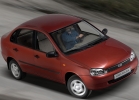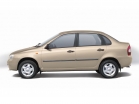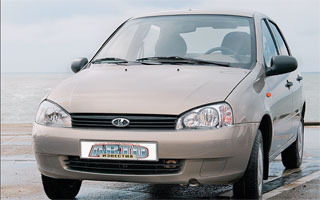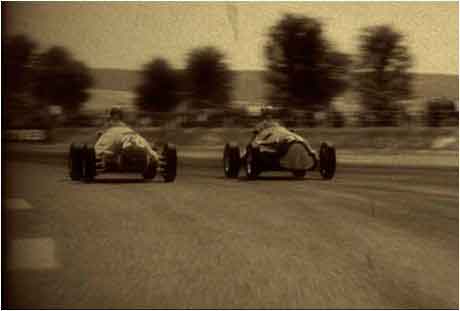Test drive vaz Kalina 1118 sedan since 2004 sedan
"Kalina" today and tomorrow
In August, at the 5th Russian International Auto Show, the VAZ will present the final version of the viburnum family. The beginning of the serial production of these machines is scheduled for the end of 2004. The first VAZ-1118 sedan will stand on the stream.Meet you with the VAZ-1118 sedan, we will only make a conversation about the concept of this machine. It is the same as in the photographs that you will not see the car: by August, the VAZ will develop a new design. In addition, a more advanced two hundredth -eater has already replaced the hundredth series. At the same time, the chassis, the power unit and the interior of the VAZ-1118 are determined almost finally.
Recall that in 1999, the VAZ-1119 hatchback was represented at the Moscow Car Salon, which we spoke in detail in the December issue of the magazine for the same year. The premiere of the VAZ-1118 sedan took place on the MIMS-2000. The Kalina family also includes the VAZ-1117 station wagon and the compact minivan VAZ-1120.
Note that for the first time the launch of cars of the new family in production is led by a specially created project directorate.
VAZ-1118 Kalina is positioned as a compact city segment of V. Western Europe (VW Polo Classic, Rkoda Fabia Sedan) are not particularly popular. More often, segment sedans are found in developing countries (Fiat Siena, Renault Clio Symbol).
The main difference between the sedan and the VAZ -1119 hatchback is a three -way layout with an unexpectedly expressed trunk, the capacity of which increased from 260 to 420 liters. The indicator, however, is not outstanding: in the above -mentioned foreign cars - 455-510 liters. However, the back of the rear seat folding in parts will significantly expand the possibilities of transporting luggage. We also note a sufficient value of the opening of the trunk cover and the tolerable step between the floor and the plane of the connector.
If earlier viburnum resembled a gnome (due to the use of a head optics from an electric car with a gnome), then in the current sketches it is more like a Vazovsky relatives. The wipers are now covered with stamping on the hood, the door handles are made like European ones, but the non-brown-megal third stop signal will most likely migrate from the lid of the trunk under the ceiling of the salon.
The doors open wide, which provides convenience of landing. The adjustment of the driver's seat noted on the hatchback will not be at all at all executions, although, in principle, standard adjustments are enough here. Sitting from behind is less comfortable than in the VAZ -1119 - the head rests on the ceiling. In a serial machine, this drawback will disappear, since the stiffness and height of the seat will change.
The planting of the riders in Kalina is more vertical than in an ordinary passenger car. The car is shorter than others, but also higher (1500 mm), and even exceeds the eight in width.
The design of the dashboard, the central console and the torpedo as a whole has improved. Now they are functionally divided and contain the controls of car systems adopted everywhere in Europe. The KP lever has a lock from randomly turning on the rear gear. The standard ten steering wheel spoils the picture somewhat - it would be more appropriate here, designed specifically for viburnum.
The Crash tests carried out revealed the complete compliance of the design of the car with the requirements of safety during the lateral blow and minor deviations from the norms with the brackets. All comments on the results of the tests were taken into account when creating prototypes of two hundred series.
Four motors (1.6-1.7 liters) are supposed to be installed on Kalina, leading their pedigree from both classics and front-wheel drive vases. In our case, the machine was equipped with the VAZ-11183 engine (1.6 liters; 79 hp) with two valves on the cylinder and the intake pipe of the variable length, which led to a fairly gentle characteristic of the torque with its good value on the bottoms. This sedan is quite flexible and comfortable in management.
Our long -standing dispute about the advisability of using such large power units on Kalina (see the fifth wheel No. 12'99) did not end - both sides remained in their opinion. Strengthening the body to ensure security requirements for strikes led to an increase in the equipped mass to 1000-1080 kg. The investigation is the installation of more solid and traction engines that provide acceptable dynamics.
In foreign serial analogues, the body is slightly easier (950-1050 kg), and smaller engines have much better indicators. The sample can be the Renault Clio Symbol with its last 16-valve engine (1.4 l), with a smaller weight with large dimensions (length 4150 mm).
Looking into the engineering space, we noted a weak study of repairs. The wiper drive has become accessible not only for repairmen, but also for the owners of the car, which can not be said about the expansion tank - in the event of a breakdown, it is in no way removed it due to large motor dimensions. The calculation for the entire period of its operation in the car is still weak.
The transmission and chassis inherited from the eight and dozens. However, there are significant differences. The rut of the wheels of the viburnum is enlarged in front and behind, which made it possible to achieve greater expanse in the cabin and - as far as possible, the engine compartment. The upper support of the front racks is two -stage, with conical springs. A reptile stabilizer is introduced into the rear suspension.
The car moves smoothly. The burden of the motor is felt (133 Nm at 2800 min-1), although, in our opinion, the transfer numbers in the CP could be different. Acceleration is confident, dynamic, viburnum provokes an active driving style.
The steering is equipped with an electric power - an indispensable thing in the parking lot. However, we will refrain from evaluating his work. At some point, the steering wheel seemed sharp, but completely devoid of reactive effort. In addition, the radius of the turn is too great for such a machine.
The potassium suspension can be called more collected than dozens. Something like a golden middle between the VAZ-2108 and -2110. That is why the controllability of the car made the most pleasant impression, as, indeed, informative brakes.
The Vazov brainchild is just learning to walk along the roads. However, now it is necessary to think about his consumer address. If the model is designed to fill the gap in the V -segment of our market, this is one. If it replaces any of the current models on the conveyor - completely different. A very important factor is the market price of viburnum. By the way, the car may well become in demand as a replacement of Tavria.
In conclusion, we recall that the Directorate of Technical Development of the VAZ has long been going to create consumer groups to assess promising cars. The opinion of representatives of these groups could reflect real requirements for both the new product as a whole and to such aspects as the level of basic configuration, cost, and maintenance. It's time to return to the problem.
The chief designer of the plant Petr Mikhailovich Prusov tells about the main areas of the work of the Technical Development of AvtoVAZ.
- At what stage is the Kalina project?
- It includes four cars, the development of each of which is carried out according to the plan.
For the 19th and 18th models, production is being prepared. Priority is given to the VAZ-1118 sedan.
According to the VAZ-1117 station wagon, the issuance of design documentation for the manufacture of the first series of samples is completed.
The documentation on the compact minivan VAZ-1120 will be issued by the end of the year. Then we will begin the manufacture of prototypes. The start of the production and the assembly site of this machine have not yet been determined. One thing I can say: if everything works out as planned, then the VAZ-1120 will not be produced even on the OPP.
Since the production of viburnum will unfold in new areas, the number of cars produced will increase significantly. By 2006, we hope to overcome the line of 750 thousand cars a year, and then bring this indicator to 900 thousand.
- How long will it last on the classic conveyor?
- It all depends on how the living standards of Russians will grow. While we live in a very deaf society, I propose to introduce the concept of a social car. I am already being agreed on this issue with many interested parties: the traffic police, the State Standard, the Dmitrovsky training ground, etc.
This concept follows from today's capabilities of the population: most of the solvent buyers are able to lay out a maximum of $ 4000 for the car. What can you buy for that kind of money, for example, in Moscow? Most likely, an old foreign car. And what is our classic worse?
Social cars were and are even in developed countries. For example, in Italy this concept was canceled only in 1998. In Japan, it exists to this day, however, in a slightly altered form.
Someone will say that I will lobby for the interests of my factory. But in fact, any car, the cost of which fits $ 4000, can get social status. By the way, less than a third of manufactured cars will fall on a vase for this term, while the entire production program of the Muscovite, Izhmash-Auto and 60% of the UAZ release corresponds to the status of a social car.
Returning to the question asked, I can say that the classic will be produced for another ten years. Of course, not in such volumes as before (over 220 thousand pcs.), And not all directly with us.
- What kind of refinement does a new field require?
- The design of the new Niva will be finalized according to the terms of the agreement. One of the points of the program is to strengthen passive safety. Front air pillows for the driver and passenger will appear, as well as belts with a pre -trial detention center and restriction of the tension force. By the way, the trials for the side blow showed that the VAZ-2123 does not require the installation of side pillows. In addition, there are wishes of the OPEL company to install the pedal unit, a hatch in the roof, a pre -heater and an autonomous webasto heater, air conditioning and ABS. Moreover, all this should be mounted on the conveyor.
As for the increase in the factory price of the VAZ-2123 by approximately $ 100, it will affect only the basic configuration, which will include the pedal Opel unit.
The basic equipment will not include other engines, for example, Opelian Ecotec or Fiat diesel. If there is a need for these power units, then appropriate additions to the agreement will appear.
The purpose of the refinement is one - to bring the field in line with the standards adopted in Western Europe.
Technical characteristics VAZ-11183 Kalina
Body - 4 -door sedan
Number of places, people. - 5
Equipped mass, kg - 1000-1080
Full mass, kg - 1555
Dimensions (length/width/height), mm - 4040/1670/1500
Base, mm - 2470
Maximum speed, km/h - 170
Acceleration time to 100 km/h, s - 12.5
Fuel consumption, l/100 km (according to Dir. 93/116) - 7.4
Engine:
- type - 4 -cylinder., gasoline
- working volume, cm3 - 1596
- Power, L.S. at MIN -1 - 79/5600
- Torque, NM at MIN -1 - 133/2800
- power supply - distributed injection
Transmission - mechanical., 5 -speed
Tire size - 175/70R13
Wheel suspension:
- Front - independent, mcpherson
- rear - semi -dependent
Brakes:
- front - disk
- rear - drum
The steering - rheck, with electro -power.
The principle of operation of the steering wheel power power can be considered by the example of this device for the Opel Corsa car.
The electronic amplifier is an aggregate attached to the steering column. Its base is a direct current electric motor, feeds from a network with a voltage of 12V. The electronic unit instantly processes the incoming data: the force attached to the steering wheel, the speed of the car, the engine speed, etc. In this case, through the controller itself, the control unit provides the force required in each case.
In addition to the fact that the electric amplifier has the abilities of a conventional hydraulic wrap, it has fewer components, is more easy and requires less energy consumption to provide the drive. All taken together allows Opel Corsa to save from 2 to 5% of the fuel consumed.
Text: Sergey Zhukov
Source: Magazine 5 wheel [06/2001]









